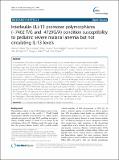| dc.description.abstract | In holoendemic Plasmodium falciparum transmission areas such as western Kenya, severe
malarial anemia [SMA, hemoglobin (Hb)< 6.0 g/dL, with any density parasitemia] is the most
common clinical manifestation of severe malaria resulting in high rates of pediatric morbidity
and mortality in these regions. Previous studies associated interleukin (IL)-13 with
pathogenesis of different infectious diseases, including P. falciparum malaria. However, the
functional roles of polymorphic variants within the IL-13 promoter in conditioning
susceptibility to SMA remain largely unexplored. As such, the association between the IL-13
variants-7402 T/G (rs7719175) and-4729G/A (rs3091307) and susceptibility to SMA was
determined in children (n= 387) presenting with clinical symptoms of falciparum malaria and
resident in a holoendemic transmission region in western Kenya. Our results indicated no … | en_US |

